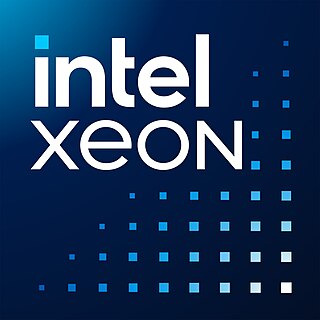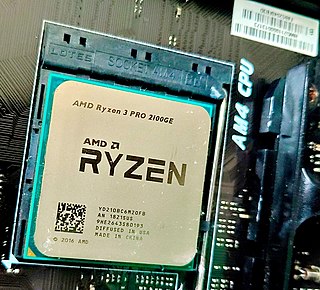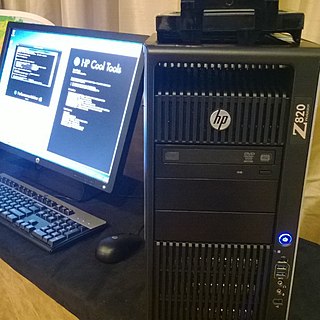
Xeon is a brand of x86 microprocessors designed, manufactured, and marketed by Intel, targeted at the non-consumer workstation, server, and embedded markets. It was introduced in June 1998. Xeon processors are based on the same architecture as regular desktop-grade CPUs, but have advanced features such as support for error correction code (ECC) memory, higher core counts, more PCI Express lanes, support for larger amounts of RAM, larger cache memory and extra provision for enterprise-grade reliability, availability and serviceability (RAS) features responsible for handling hardware exceptions through the Machine Check Architecture (MCA). They are often capable of safely continuing execution where a normal processor cannot due to these extra RAS features, depending on the type and severity of the machine-check exception (MCE). Some also support multi-socket systems with two, four, or eight sockets through use of the Ultra Path Interconnect (UPI) bus, which replaced the older QuickPath Interconnect (QPI) bus.
Tick–tock was a production model adopted in 2007 by chip manufacturer Intel. Under this model, every microarchitecture change (tock) was followed by a die shrink of the process technology (tick). It was replaced by the process–architecture–optimization model, which was announced in 2016 and is like a tick–tock cycle followed by an optimization phase. As a general engineering model, tick–tock is a model that refreshes one side of a binary system each release cycle.

Intel Core is a line of multi-core central processing units (CPUs) for midrange, embedded, workstation, high-end and enthusiast computer markets marketed by Intel Corporation. These processors displaced the existing mid- to high-end Pentium processors at the time of their introduction, moving the Pentium to the entry level. Identical or more capable versions of Core processors are also sold as Xeon processors for the server and workstation markets.

Xeon Phi is a discontinued series of x86 manycore processors designed and made by Intel. It was intended for use in supercomputers, servers, and high-end workstations. Its architecture allowed use of standard programming languages and application programming interfaces (APIs) such as OpenMP.

Ryzen is a brand of multi-core x86-64 microprocessors designed and marketed by Advanced Micro Devices (AMD) for desktop, mobile, server, and embedded platforms based on the Zen microarchitecture. It consists of central processing units (CPUs) marketed for mainstream, enthusiast, server, and workstation segments and accelerated processing units (APUs) marketed for mainstream and entry-level segments and embedded systems applications.

Epyc is a brand of multi-core x86-64 microprocessors designed and sold by AMD, based on the company's Zen microarchitecture. Introduced in June 2017, they are specifically targeted for the server and embedded system markets.
Sapphire Rapids is a codename for Intel's server and workstation processors based on the Golden Cove microarchitecture and produced using Intel 7. It features up to 60 cores and an array of accelerators, and it is the first generation of Intel server and workstation processors to use a chiplet design.
Process–architecture–optimization is a development model for central processing units (CPUs) that Intel adopted in 2016. Under this three-phase (three-year) model, every microprocessor die shrink is followed by a microarchitecture change and then by one or more optimizations. It replaced the two-phase (two-year) tick–tock model that Intel adopted in 2006. The tick–tock model was no longer economically sustainable, according to Intel, because production of ever smaller dies becomes ever more costly.

Zen 4 is the codename for a CPU microarchitecture designed by AMD, released on September 27, 2022. It is the successor to Zen 3 and uses TSMC's N6 process for I/O dies, N5 process for CCDs, and N4 process for APUs. Zen 4 powers Ryzen 7000 performance desktop processors, Ryzen 8000G series mainstream desktop APUs, and Ryzen Threadripper 7000 series HEDT and workstation processors. It is also used in extreme mobile processors, thin & light mobile processors, as well as EPYC 8004/9004 server processors.
Zen 5 is the codename for an upcoming CPU microarchitecture by AMD, shown on their roadmap in May 2022, destined for a release in July 2024. It is the successor to Zen 4 and is fabricated on TSMC's N4X and N3E processes.

Ampere Computing LLC is an American fabless semiconductor company based in Santa Clara, California that develops processors for servers operating in large scale environments. Ampere also has offices in: Portland, Oregon; Taipei, Taiwan; Raleigh, North Carolina; Bangalore, India; Warsaw, Poland; and Ho Chi Minh City, Vietnam.

HP Z is a series of professional workstation computers developed by Hewlett-Packard. The first-generation desktop products were announced in March 2009, replacing the HP 9000 xw series. The product line expanded to mobile with the announcement of ZBook in September 2013, replacing HP's EliteBook W-series mobile workstations. The Z workstations mainly compete against Dell's Precision workstations, Lenovo's ThinkStation and ThinkPad P series workstations, as well as Apple's Mac Pro and MacBook Pro.

Golden Cove is a codename for a CPU microarchitecture developed by Intel and released in November 2021. It succeeds four microarchitectures: Sunny Cove, Skylake, Willow Cove, and Cypress Cove. It is fabricated using Intel's Intel 7 process node, previously referred to as 10 nm Enhanced SuperFin (10ESF).
Inspur Server Series is a series of server computers introduced in 1993 by Inspur, an information technology company, and later expanded to the international markets. The servers were likely among the first originally manufactured by a Chinese company. It is currently developed by Inspur Information and its San Francisco-based subsidiary company - Inspur Systems, both Inspur's spinoff companies. The product line includes GPU Servers, Rack-mounted servers, Open Computing Servers and Multi-node Servers.
Emerald Rapids is the codename for Intel's fifth generation Xeon Scalable server processors based on the Intel 7 node. Emerald Rapids CPUs are designed for data centers; the roughly contemporary Raptor Lake is intended for desktop and mobile usage. Nevine Nassif is a chief engineer for this generation.
Granite Rapids is the codename for 6th generation Xeon Scalable server processors designed by Intel, set to launch in 2024. Featuring up to 128 P-cores, Granite Rapids is designed for high performance computing applications. 6th generation Sierra Forrest processors with up to 288 E-cores that launched in June 2024 before Granite Rapids.
Raptor Lake is Intel's codename for the 13th and 14th generations of Intel Core processors based on a hybrid architecture, utilizing Raptor Cove performance cores and Gracemont efficient cores. Like Alder Lake, Raptor Lake is fabricated using Intel's Intel 7 process. Raptor Lake features up to 24 cores and 32 threads and is socket compatible with Alder Lake systems. Like earlier generations, Raptor Lake processors also need accompanying chipsets.
LGA 4677 is a zero insertion force flip-chip land grid array (LGA) CPU socket designed by Intel, compatible with Sapphire Rapids server and workstation processors, which was released in January 2023.
LGA 7529 is an upcoming zero insertion force flip-chip land grid array (LGA) socket designed by Intel that will be used by the future Sierra Forest, a line of E-Core Xeon processors designed for heavily multithreaded cloud workloads, and Granite Rapids, the all P-Core mainstream Xeon microprocessors. The socket is also expected to support the mainstream successor to Granite Rapids, Diamond Rapids. The first pictures of the Intel 'Birch Stream' platform, a two socket engineering motherboard featuring dual LGA 7529 sockets, was posted on January 31, 2023, by Yuuki_Ans.
Meteor Lake is Intel's codename for the first generation of Intel Core Ultra mobile processors, and was officially launched on December 14, 2023. It is the first generation of Intel mobile processors to use a chiplet architecture which means that the processor is a multi-chip module. Tim Wilson led the system on a chip development for this generation microprocessor.










